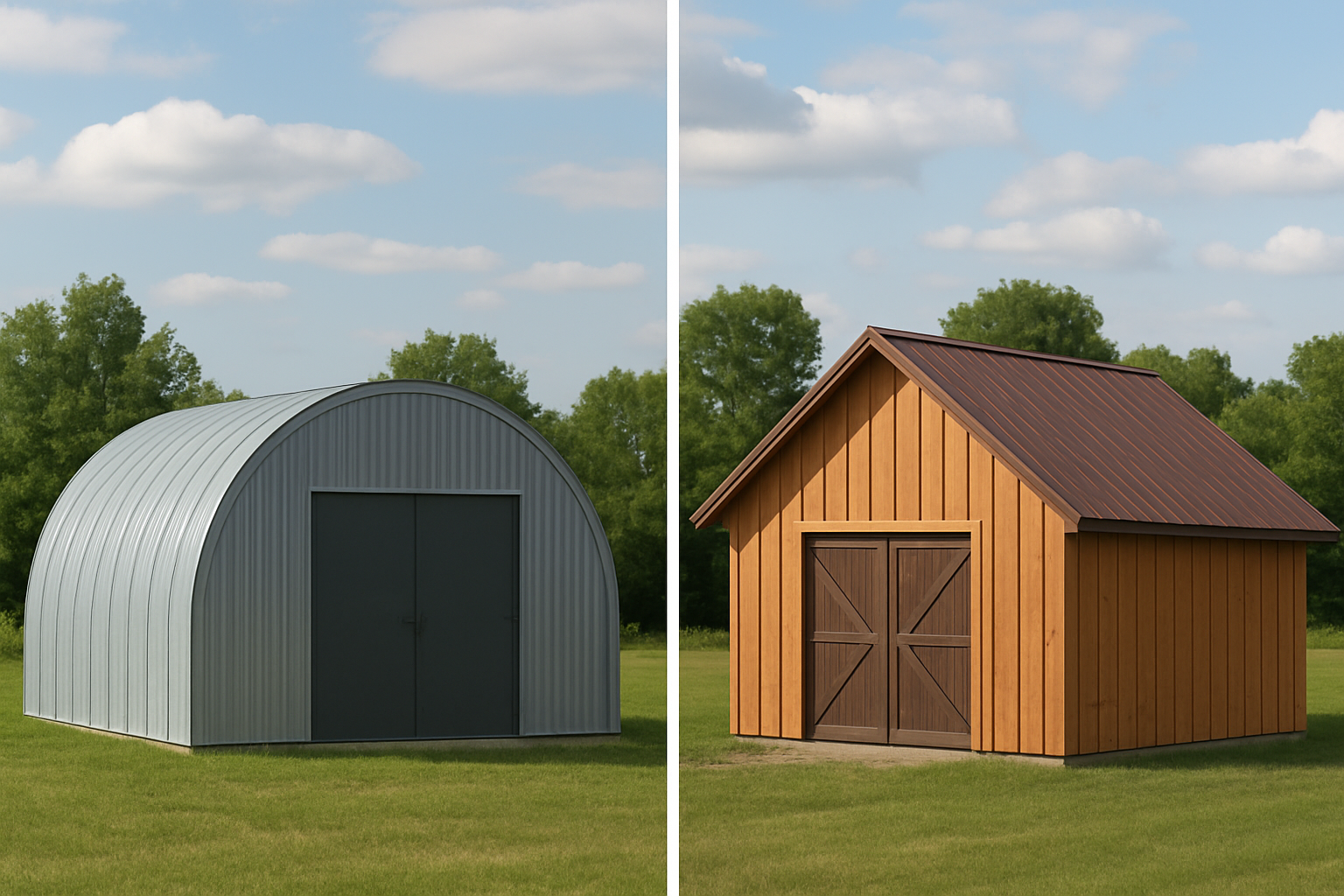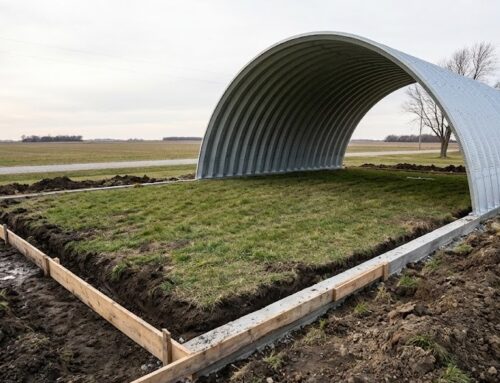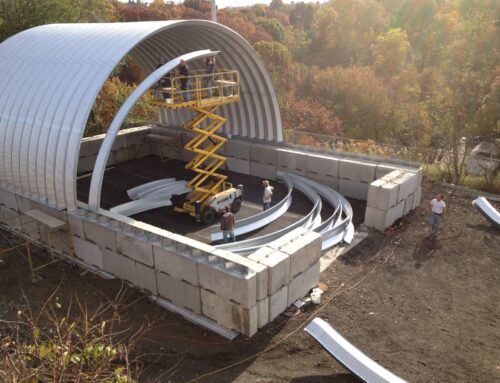
Are you considering a new building for your farm, business, or storage needs? Two popular options often top the list: Quonset huts (steel barns) and pole barns. While both serve similar purposes, they differ significantly in construction, durability, and long-term value.
This comprehensive comparison will help you understand which building type best fits your specific needs, budget, and long-term goals.
What is a Quonset Hut?
A Quonset hut is a lightweight, prefabricated steel structure with a distinctive arched design. Originally developed for military use, modern Quonset huts like those from Agribilt feature heavy-duty commercial Galvalume coated steel, 100% clearspan design, and simple nut-and-bolt assembly.
The arch design distributes weight evenly, creating incredibly strong structures that can withstand harsh weather conditions without internal support posts.
What is a Pole Barn?
A pole barn, also called a post-frame building, uses vertical posts buried directly in the ground or set in concrete to support the roof structure. These buildings typically feature wood framing with metal or wood siding and are commonly used for agricultural and storage applications.
Pole barns rely on interior posts and trusses to support the roof, which can limit interior space flexibility.
Key Differences: Quonset Huts vs. Pole Barns
Construction and Foundation Requirements
Quonset Huts:
- Simple floating footer, no need to dig to the frostline
- Use engineered steel arches that bolt together
- No interior support posts needed
- Can be assembled by DIY builders with basic tools
- Meets IBC, CAN/CSA A660, and other building codes
Pole Barns:
- Posts are buried directly in ground or set in concrete
- Require precise post placement and alignment
- Need interior posts every 8-12 feet for roof support
- May require professional installation for proper alignment
- Foundation requirements vary by local building codes
Durability and Weather Resistance
Quonset Huts:
- Galvalume coating provides superior corrosion resistance
- Arch design naturally sheds wind, snow, and rain
- Fire-resistant steel construction
- Pest and rot-proof materials
- Engineered to withstand extreme weather conditions
Pole Barns:
- Wood posts susceptible to rot, insects, and moisture
- Require regular treatment and maintenance
- Metal siding can dent or corrode over time
- More vulnerable to fire damage
- Interior posts can shift or settle over time
Usable Interior Space
Quonset Huts:
- 100% clearspan design with no interior obstructions
- Maximum storage efficiency and flexibility
- Easy to rearrange interior layouts
- Full width and height utilization
- No posts to work around when moving equipment
Pole Barns:
- Interior posts every 8-12 feet limit space usage
- Posts create obstacles for large equipment
- Reduced storage efficiency
- Limited flexibility for future layout changes
- Trusses may further restrict overhead space
Cost Comparison: Initial vs. Long-Term
Quonset Huts:
- Higher initial investment
- Minimal maintenance costs over decades
- No rot, pest, or weather damage repairs
- Excellent resale value
- Lower long-term total cost of ownership
Pole Barns:
- Lower upfront costs
- Ongoing maintenance expenses (wood treatment, repairs)
- Potential for significant repair costs (post replacement, rot damage)
- Depreciation over time
- Higher long-term ownership costs
Maintenance and Upkeep
Quonset Huts:
- Virtually maintenance-free
- No wood to treat or replace
- Occasional cleaning is primary maintenance
- Galvalume coating lasts decades
- No pest control issues
Pole Barns:
- Regular wood treatment required
- Post inspection and potential replacement
- Ongoing pest and rot prevention
- Paint and siding maintenance
- Foundation settling concerns
Customization and Expandability
Quonset Huts:
- Various width and length options
- Easy to extend length by adding sections
- Multiple door and window configurations
- Insulation options available
- Can accommodate various end wall designs
Pole Barns:
- Traditional building appearance
- Standard post spacing limits modifications
- Expansion requires additional posts and footings
- More complex structural modifications
- Limited by original post placement
Environmental Factors
Climate Considerations
Quonset Huts excel in:
- High wind areas (aerodynamic design)
- Heavy snow loads (arch distributes weight)
- Areas with extreme temperature fluctuations
- Humid climates (no wood to rot)
- Fire-prone regions (non-combustible materials)
Pole Barns may struggle with:
- Moisture and humidity (wood rot risk)
- Extreme weather events (structural vulnerability)
- Areas with aggressive insects or pests
- Regions with frequent freeze-thaw cycles
Energy Efficiency
Quonset Huts:
- Excellent insulation options
- Minimal thermal bridging
- Reflective Galvalume coating reduces heat gain
- Efficient heating and cooling distribution
Pole Barns:
- Insulation limited by post-frame construction
- Thermal bridging through wood posts
- More challenging to achieve consistent temperatures
- Higher energy costs for climate control
Which Building is Right for You?
Choose a Quonset Hut if you:
- Need maximum interior space without obstructions
- Want minimal long-term maintenance
- Live in areas with harsh weather conditions
- Plan to use the building for decades
- Value long-term cost savings over initial investment
- Need a fire-resistant structure
- Want DIY assembly capability
- Require building code compliance and certifications
Choose a Pole Barn if you:
- Have a very tight initial budget
- Prefer traditional building appearance
- Need immediate construction with minimal site prep
- Plan short-term use (5-10 years)
- Don’t mind ongoing maintenance requirements
- Have specific aesthetic requirements
Why Choose an Agribilt Quonset Hut?
Agribilt’s steel buildings offer distinct advantages over both traditional Quonset huts and pole barns:
Superior Materials:
- Heavy Duty Commercial Galvalume Coated steel
- Made in USA with rigorous quality control
- Engineered to exceed industry standards
Proven Performance:
- Florida Product Approval for hurricane resistance
- IBC, CAN/CSA A660, CWB W47.1, W59, CE Mark certifications
- AWS D1.3 welding standards compliance
Customer-Focused Design:
- Simple nut-and-bolt assembly
- Comprehensive assembly instructions
- Technical support throughout construction
- Customizable to specific needs
Frequently Asked Questions
Q: Are Quonset huts more expensive than pole barns? A: While Quonset huts have higher upfront costs, they offer better long-term value through minimal maintenance, superior durability, and longer lifespan.
Q: Can I build either structure myself? A: Quonset huts are designed for DIY assembly with basic tools. Pole barns require more construction experience and often professional installation for proper alignment.
Q: Which building lasts longer? A: Quonset huts typically last 40+ years with minimal maintenance, while pole barns may require significant repairs or replacement within 15-25 years.
Q: Do I need special permits for either building? A: Both structures typically require building permits. Quonset huts’ engineered design and certifications often simplify the permitting process.
Q: Which building is better for equipment storage? A: Quonset huts provide superior equipment storage with 100% clearspan design, allowing maximum space utilization without interior obstructions.
Making Your Decision
The choice between a Quonset hut and pole barn ultimately depends on your priorities: immediate cost savings versus long-term value, minimal maintenance versus ongoing upkeep, and maximum space efficiency versus traditional aesthetics.
For most applications requiring durability, low maintenance, and maximum usable space, steel Quonset huts represent the superior long-term investment. Their proven performance in harsh conditions, minimal maintenance requirements, and clearspan design make them ideal for agricultural, commercial, and storage applications.
Ready to explore your options? Consider how each building type aligns with your specific needs, local climate, and long-term goals to make the best choice for your investment.



